Centrifugal Model Test and Simulation of Geogrid Reinforced Backfill and EPS Interlayer on Bridge Abutment
Abstract
:1. Introduction
2. Centrifugal Model Test Design
2.1. Testing Instrument
2.2. Model Layout and Preparation
2.2.1. Model Layout
2.2.2. Test Plan
2.2.3. Model Preparation
- Production procedures and control indicators of layered compaction and vibration molding:
- Preparation of soil materials. The same dry density as in triaxial and compression tests was used to configure soil. Since the compaction work of the mold was less than that of the modified Proctor test, the corresponding optimal moisture content was larger than that obtained by the modified Proctor test, so the moisture content of the prepared soil was controlled to be slightly higher than that obtained by the modified Proctor test, and the soil sample was easy to prepare.
- Forming by the layered compaction method. According to the specified compactness and moisture content, the wet density of mold making was calculated, and the wet soil mass required for each layer was calculated. For subgrade and adjacent subgrade, the filling layer thickness was 55 mm; for the backfill area, the filling layer thickness was 32 mm.
- Soil forming of adjacent subgrade. After the adjacent subgrade soil was prepared as a whole, it was cut into steps and the backfill area was left.
- Curing of backfill materials. Lime soil and ceramsite fly ash concrete were tested after curing for 7 days.
- 2.
- Production procedure and control index of the consolidation method:
- Soil material configuration. For the soil layer of the muddy soft soil foundation, it was prepared by the consolidation method. After the soil was air dried, it was crushed and sieved (1 mm), and mixed with water to form a slurry.
- Consolidation by applying pressure step by step. For the foundation samples in the pile-supported abutment model, the graded consolidation loads were 5 kPa, 10 kPa, 20 kPa, 30 kPa, 40 kPa, 80 kPa, 120 kPa, and finally the homogeneous foundation soil with an undrained strength of 17 kPa was formed.
- 3.
- Single-hole funnel sand rain method with equal drop height:
- 4.
- Embedding of geogrids:
- 5.
- Embedding of EPS interlayer
3. Numerical Simulation of Abutment Backfill
3.1. Geometric Model
3.1.1. Calculation Model of Gravity Abutment Backfill
3.1.2. Calculation Model of Pile-Supported Abutment
3.1.3. Loading Duration
3.1.4. Selection of Calculation Parameters and Material Constitutive Relation
4. Analysis of Centrifugal Model Test Results and Simulation Results
4.1. Application of Geogrid in Clay Backfill of Gravity Abutment Structure
4.2. Application of Geogrid + EPS Interlayer in Aeolian Sand Backfill of Gravity Abutment Structure
4.2.1. Comparative Analysis of Surface Settlement of Backfill
4.2.2. Comparative Analysis of Earth Pressure
4.2.3. Comparative Analysis of Geogrid Strain
4.3. Application of Geogrid + EPS Interlayer in Aeolian Sand Backfill of Pile-Supported Abutment Structure
4.3.1. Surface Settlement Analysis of Backfill
4.3.2. Comparative Analysis of Earth Pressure
4.3.3. Comparative Analysis of Geogrid Strain
4.4. Coordination Effect of EPS Interlayer on Horizontal Displacement of Abutment Structure
5. Conclusions
- Geogrid reinforcement decreases the surface settlement of different backfills and reduces the lateral earth pressure acting on the back of the abutment.
- The reinforcement effect of geosynthetics behind the abutment can be improved by increasing the length of bottom reinforced material.
- Centrifuge model tests show that the earth pressure of abutments with EPS inclusion is reduced markedly, and the settlement of backfill without geogrid is increased.
- The earth pressure on the back of the abutment with both geogrid reinforcement and EPS inclusion is further reduced, and the differential settlement between the abutment and the backfill becomes smaller, and the tensile stress of the geogrid is obviously increased, which is very beneficial to the effect of geogrid reinforcement.
Author Contributions
Funding
Institutional Review Board Statement
Informed Consent Statement
Data Availability Statement
Acknowledgments
Conflicts of Interest
References
- Haiwei, T. Analysis of Highway Vehicle Jumping at Bridge-head between Pavement and Abutment of Express Highway. In Proceedings of the 2012 International Conference on Computer Distributed Control and Intelligent Environmental Monitoring, Zhangjiajie, China, 5–6 March 2012; IEEE: New York, NY, USA, 2012; pp. 131–136. [Google Scholar] [CrossRef]
- Ibrahim, A.; Ahmad, F.; Hassan, Z.A.; Ali, F. Strenght of expanded polystyrene (EPS)-sand as lightweight material in geotechnical engineeering. Mal. J. Fund. Appl. Sci. 2017, 9, 566–577. [Google Scholar] [CrossRef] [Green Version]
- Liu, H.; Han, J.; Jawad, S.; Parsons, R.L. Literature review of causes and mitigation techniques for bumps at ends of bridges. In Proceedings of the Geo-Congress 2020, Geotechnical Earthquake Engineering and Special Topics, Minneapolis, MN, USA, 25–28 February 2020; pp. 862–872. [Google Scholar] [CrossRef]
- Xu, J.Q.; Yan, Z.B.; Wang, Y.T.; Liao, J.F.; Mao, Z.P.; Wang, Y. Study on the effect of reinforcing method of inclined jet grouting pile to control the uneven settlement of soft soil subgrade. In Proceedings of the International Conference on Smart Transportation and City Engineering, Chongqing, China, 26–28 October 2021; SPIE: Bellingham, WA, USA, 2021; pp. 839–851. [Google Scholar] [CrossRef]
- Liu, H.; Han, J.; Parsons, R.L. Mitigation of seasonal temperature change-induced problems with integral bridge abutments using EPS foam and geogrid. Geotext. Geomembr. 2021, 49, 1380–1392. [Google Scholar] [CrossRef]
- Chen, J.; Zhang, D.; Huang, H.; Shadabfar, M.; Zhou, M.; Yang, T. Image-Based segmentation and quantification of weak interlayers in rock tunnel face via deep learning. Automat. Constr. 2020, 120, 103371. [Google Scholar] [CrossRef]
- Chen, J.; Zhou, M.; Huang, H.; Zhang, D.; Peng, Z. Automated extraction and evaluation of fracture trace maps from rock tunnel face images via deep learning. Int. J. Rock. Mech. Min. 2021, 142, 104745. [Google Scholar] [CrossRef]
- Jelušič, P.; Žlender, B. Experimental study of a geosynthetic-reinforced soil bridge abutment. Geosynth. Int. 2021, 28, 479–490. [Google Scholar] [CrossRef]
- Won, M.S.; Langcuyan, C.P. A Study of the Effects of Geosynthetic Reinforced Soil and Reinforcement Length on GRS Bridge Abutment. Appl. Sci. 2021, 11, 11226. [Google Scholar] [CrossRef]
- Zadehmohamad, M.; Bazaz, J.B. Cyclic behaviour of geocell-reinforced backfill behind integral bridge abutment. Int. J. Geotech. Eng. 2017, 13, 1–13. [Google Scholar] [CrossRef]
- Changizi, F.; Razmkhah, A.; Ghasemzadeh, H.; Amelsakhi, M. Behavior of geocell-reinforced soil abutment wall: A physical modeling. J. Mater. Civil. Eng. 2022, 34, 04021495. [Google Scholar] [CrossRef]
- Yang, G.Q.; Lv, P.; Pang, W.; Zhao, Y. Field test of reinforced soil high retaining wall with wrapped geogrid. J. Rock. Geotech. Mech. 2008, 29, 517–522. (In Chinese) [Google Scholar]
- Sun, J.S.; Yang, C.F.; Dou, Y.M.; Hao, S.W. Measurement and finite element analysis of the strain of geogrid reinforced retaining wall. Inn. Mong. Highw. Transp. 2008, 3, 4–7. (In Chinese) [Google Scholar]
- Zhao, Z.H.; Xue, X.H.; Zhou, Y.T.; Guo, Y.Y. Field test analysis of block geogrid-reinforced earth retaining wall. Sichuan Build. Sci. 2011, 37, 134–138. (In Chinese) [Google Scholar]
- Rollins, K.M.; Scott, E.; Marsh, A. Geofoam inclusions for reducing passive force on bridge abutments based on large-Scale tests. In Proceedings of the Geotechnical Frontiers 2017, Orlando, FL, USA, 12–15 March 2017; pp. 59–68. [Google Scholar]
- Ge, Z.S.; Huang, X.M. Centrifugal Modeling of Abutment Backfill with EPS Inclusion and Reinforcement. EPS 2006, 9, 447–452. [Google Scholar]
- Kyokawa, H.; Yamazaki, Y.; Koseki, J.; Konami, T.; Nishi, T.; Kubota, T. Shaking table tests on bridge abutments reinforced by EPS and geogrid. Geosynth. Int. 2021, 29, 163–173. [Google Scholar] [CrossRef]
- Fiorentino, G.; Cengiz, C.; De Luca, F.; Mylonakis, G.; Karamitros, D.; Dietz, M.; Dihoru, L.; Lavorado, D.; Briseghella, B.; Nuti, C. Integral abutment bridges: Investigation of seismic soil-structure interaction effects by shaking table testing. Earthq. Eng. Struct. Dyn. 2021, 50, 1517–1538. [Google Scholar] [CrossRef]
- Schofield, A.N.; Steedman, R.S. Recent Development of Dynamic Model Testing in Geotechnical Engineering; Cambridge University Engineering Department: Cambridge, UK, 1988; pp. 124–136. [Google Scholar]
- Yu, Y.Z.; Chen, Z.F. A review on development of shaking table system for geotechnical centrifuge. Water. Res. Hydropower Eng. 2005, 36, 19–21. (In Chinese) [Google Scholar] [CrossRef]
- Higo, Y.; Lee, C.W.; Doi, T.; Kinugawa, T.; Kimura, M.; Kimoto, S.; Oka, F. Study of dynamic stability of unsaturated embankments with different water contents by centrifugal model tests. Soils Found. 2015, 55, 112–126. [Google Scholar] [CrossRef] [Green Version]
- Cabrera, M.A.; Wu, W. Experimental modelling of free-surface dry granular flows under a centrifugal acceleration field. Granul. Matter 2017, 19, 1–10. [Google Scholar] [CrossRef]
- Miao, F.; Wu, Y.; Török, Á.; Li, L.; Xue, Y. Centrifugal model test on a riverine landslide in the Three Gorges Reservoir induced by rainfall and water level fluctuation. Geosci. Front. 2022, 13, 101378. [Google Scholar] [CrossRef]
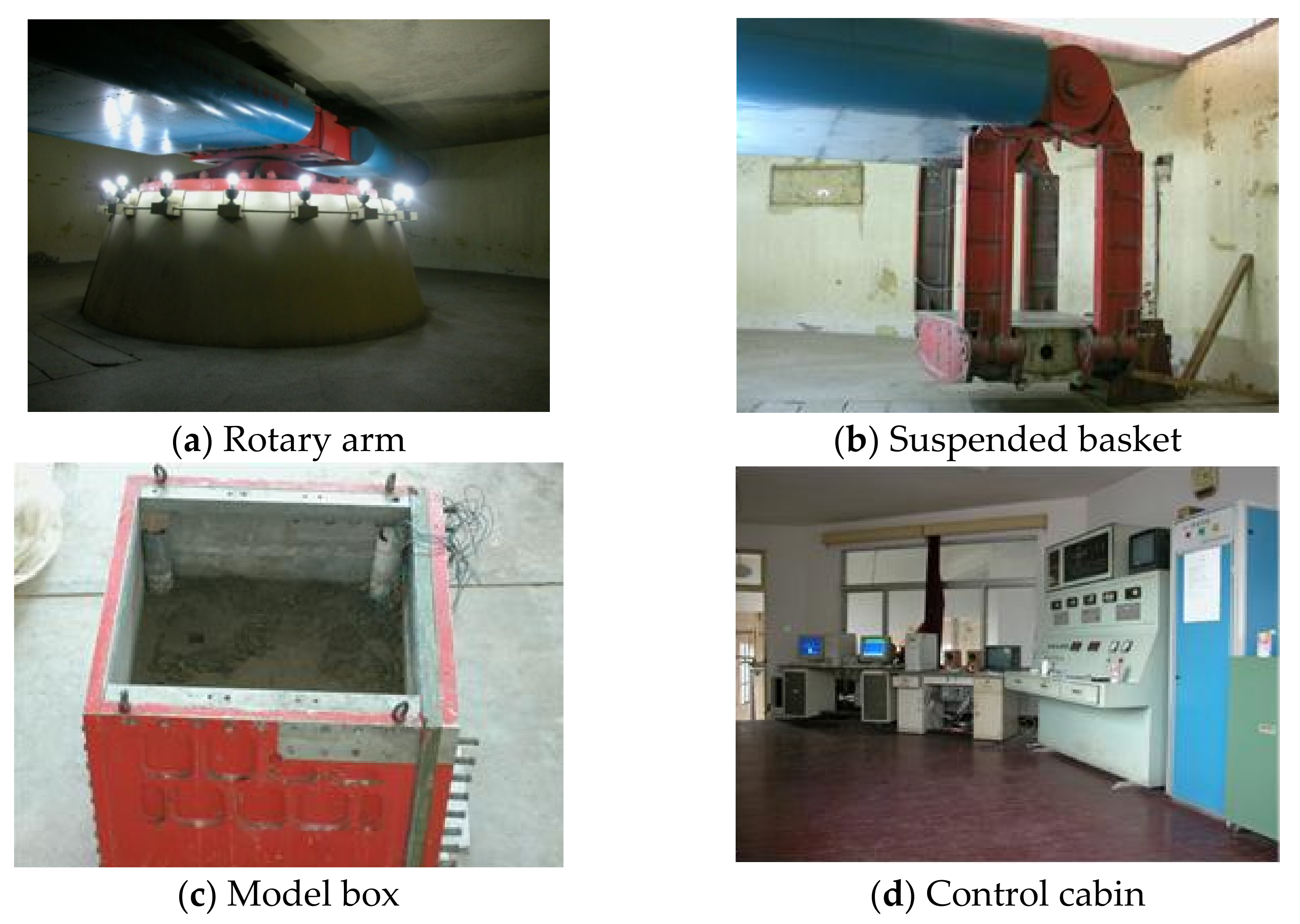
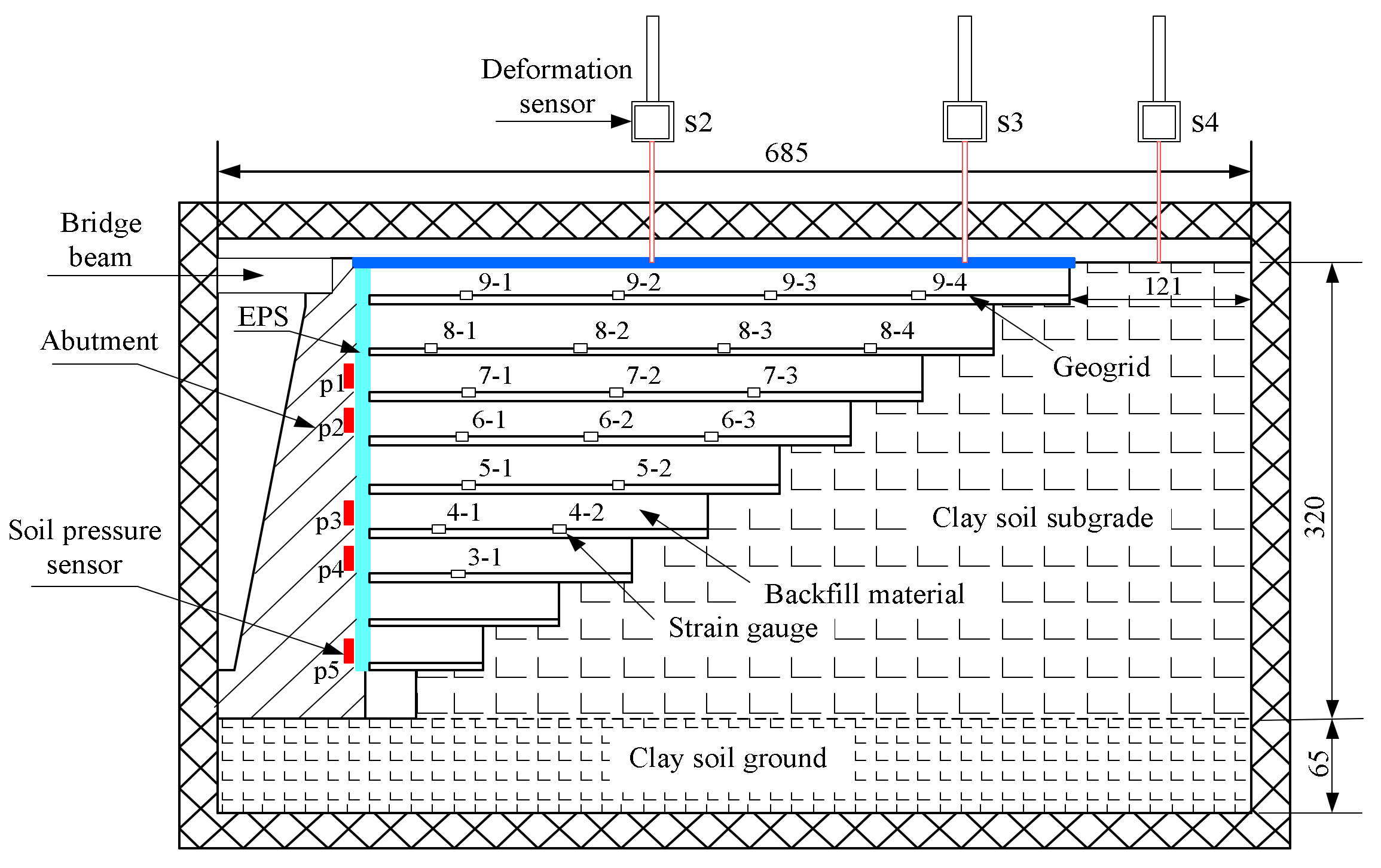

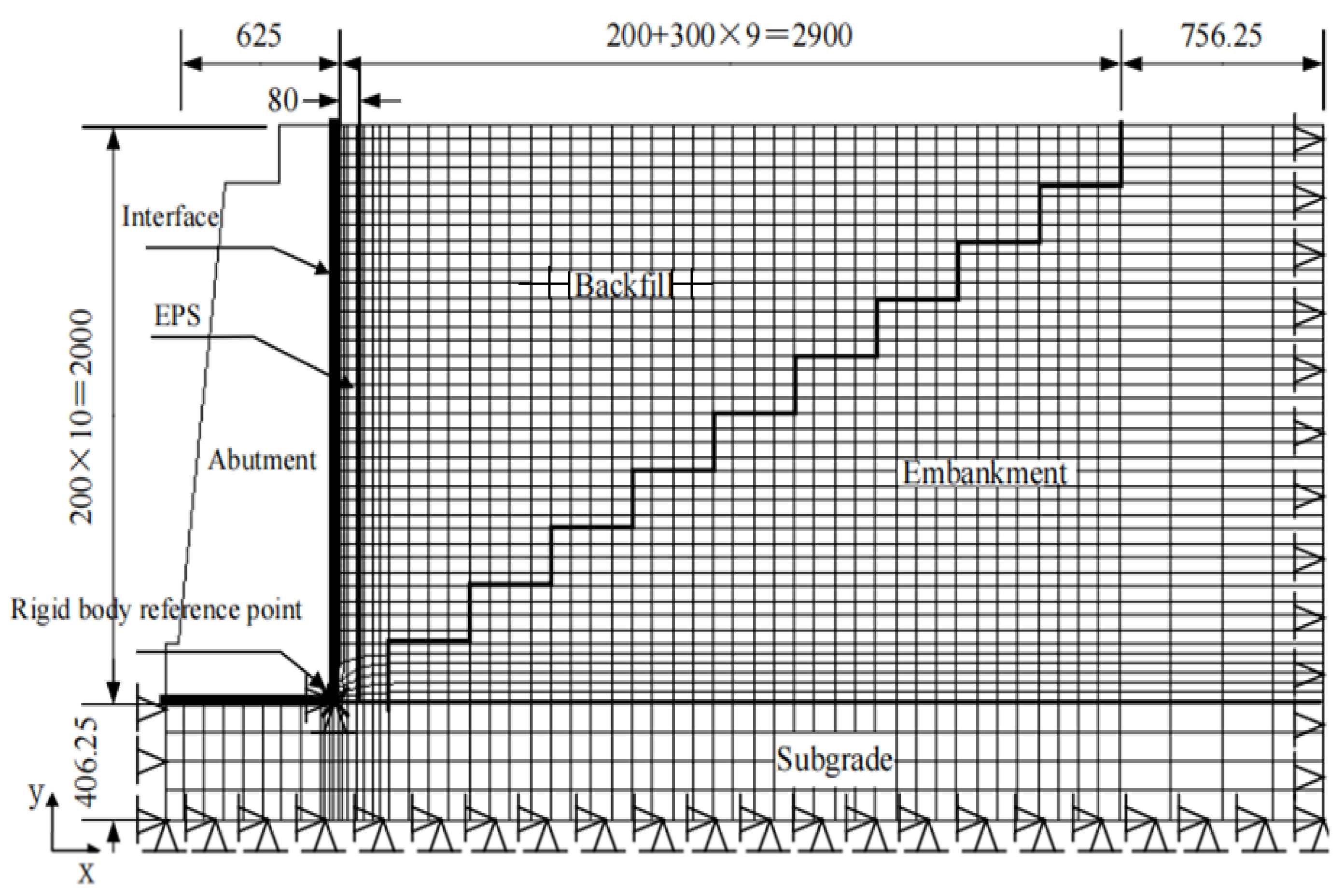

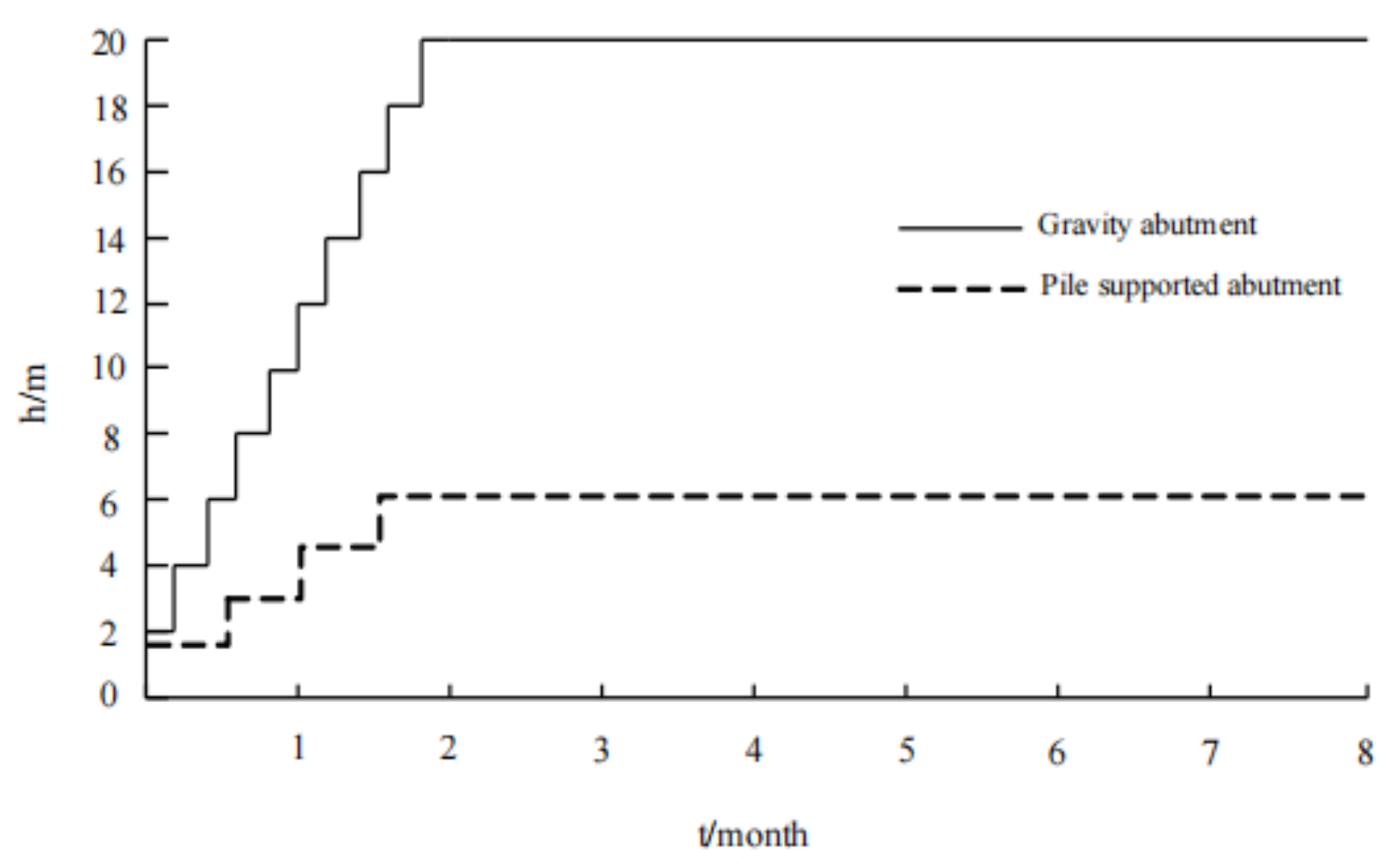
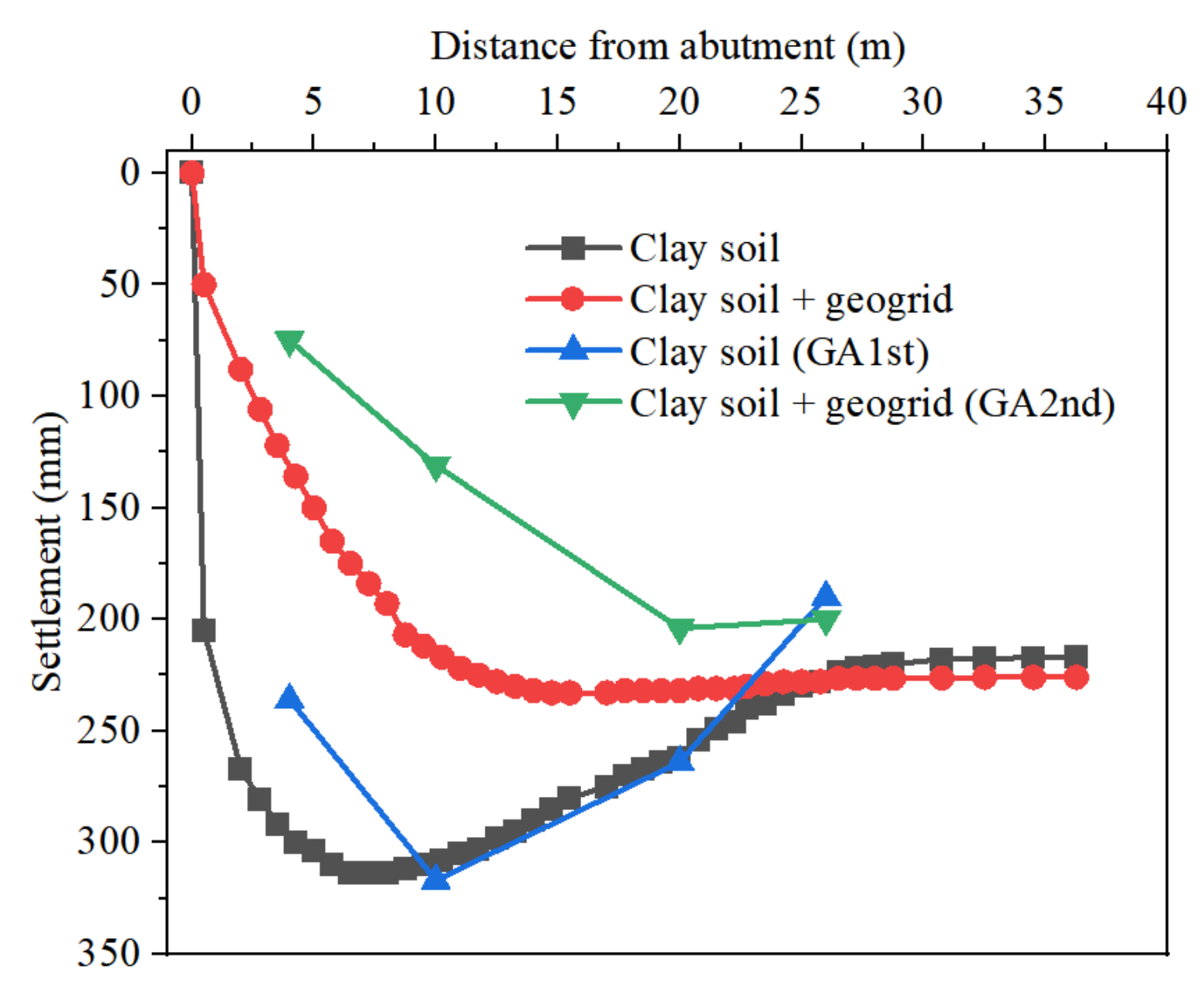


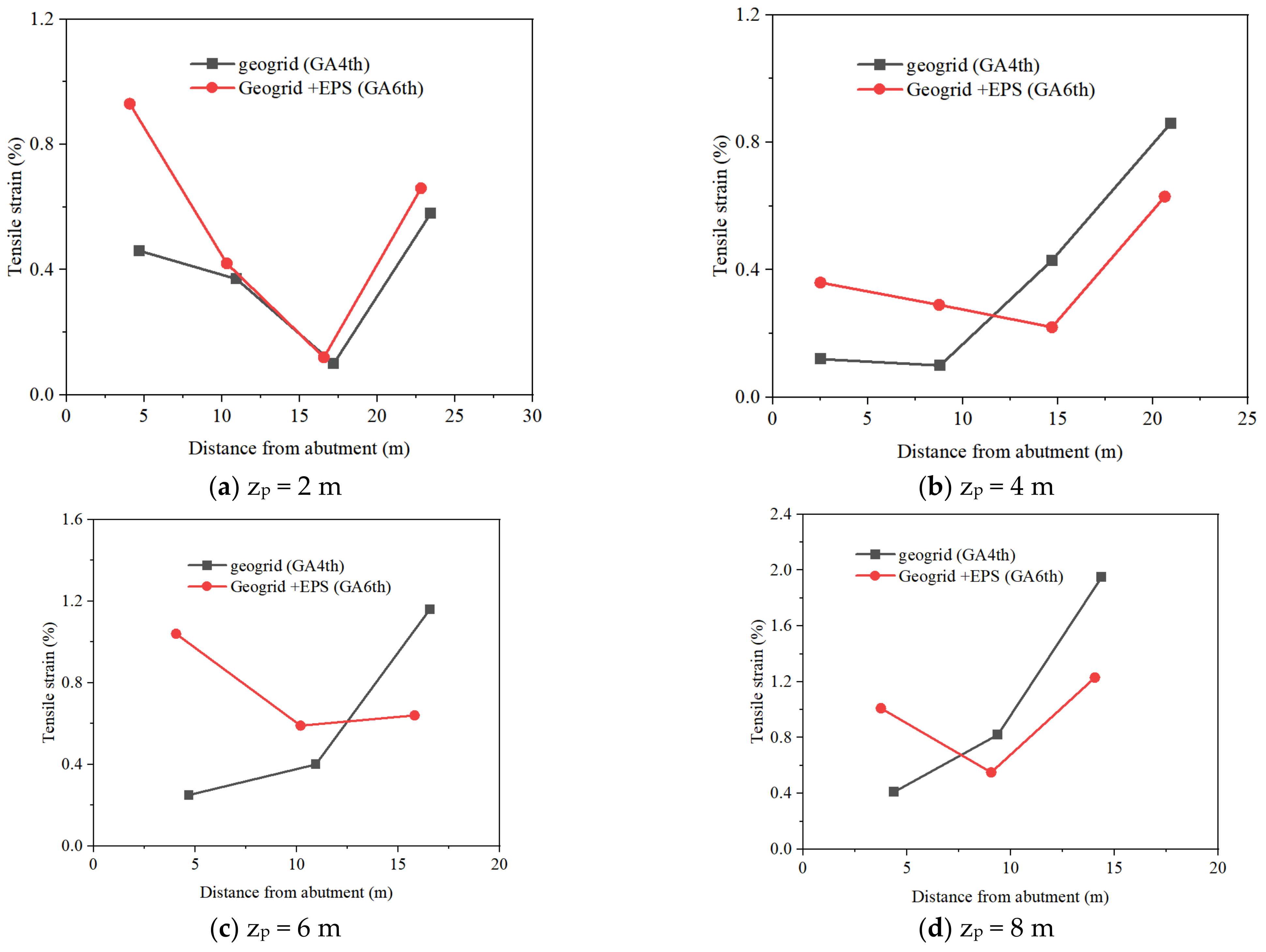



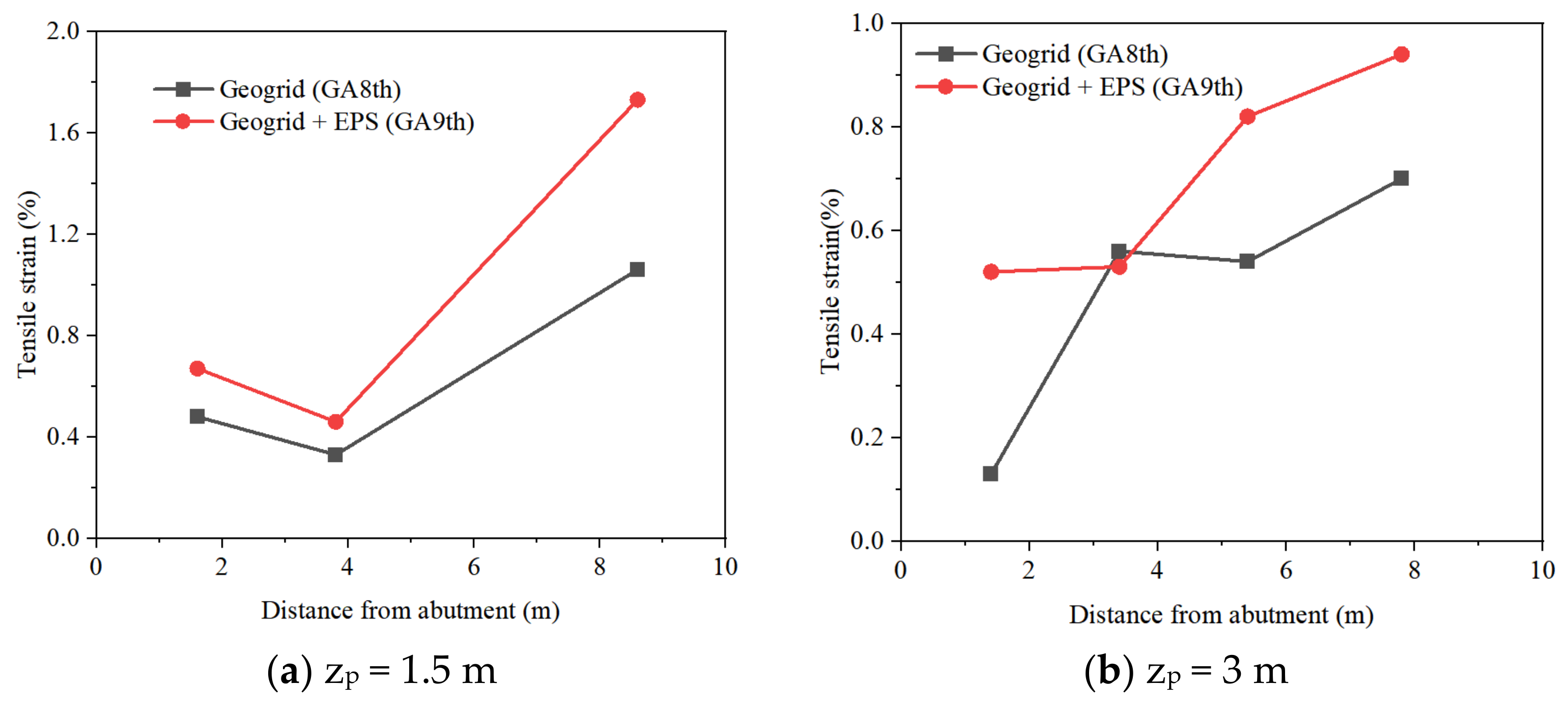

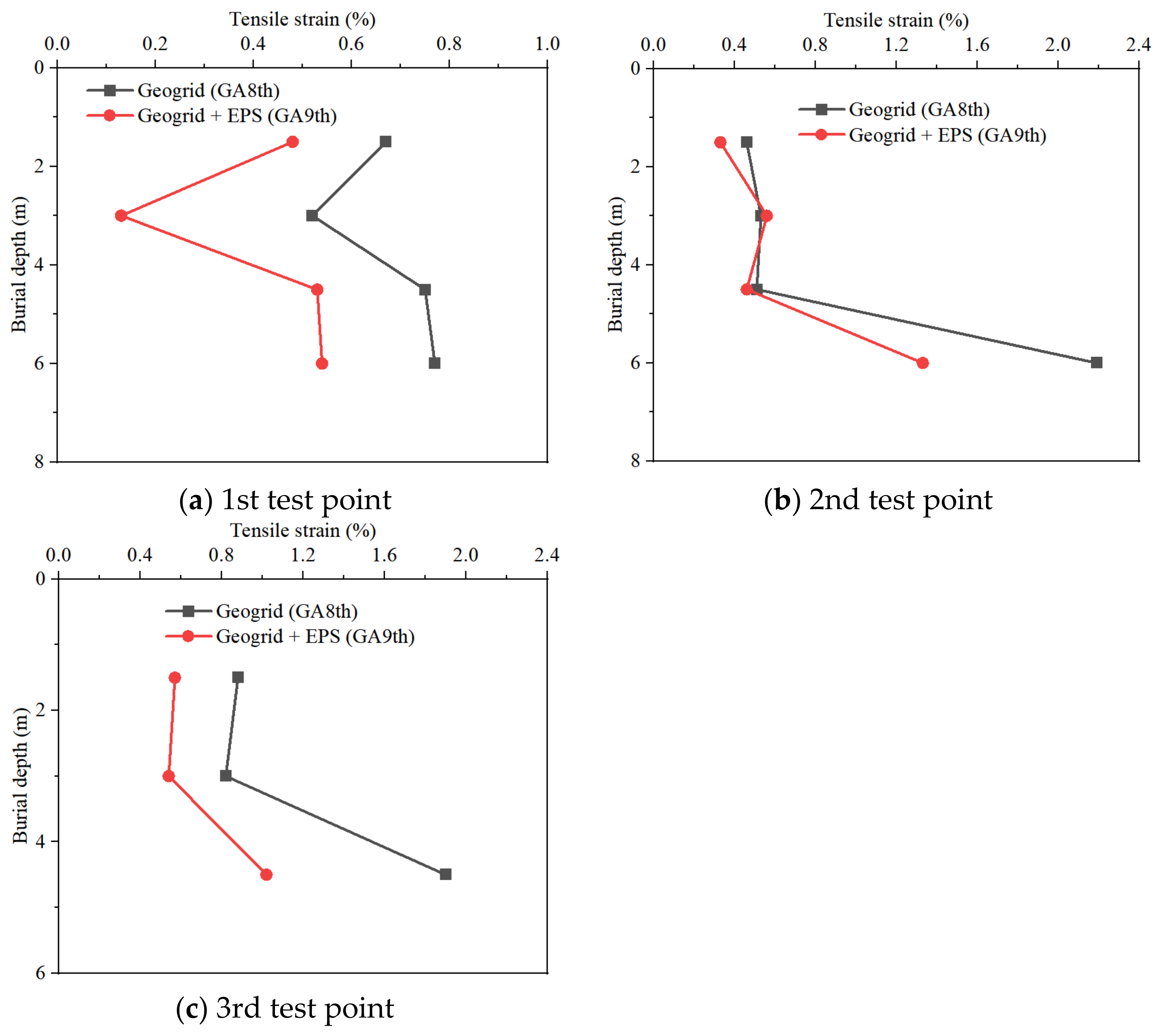
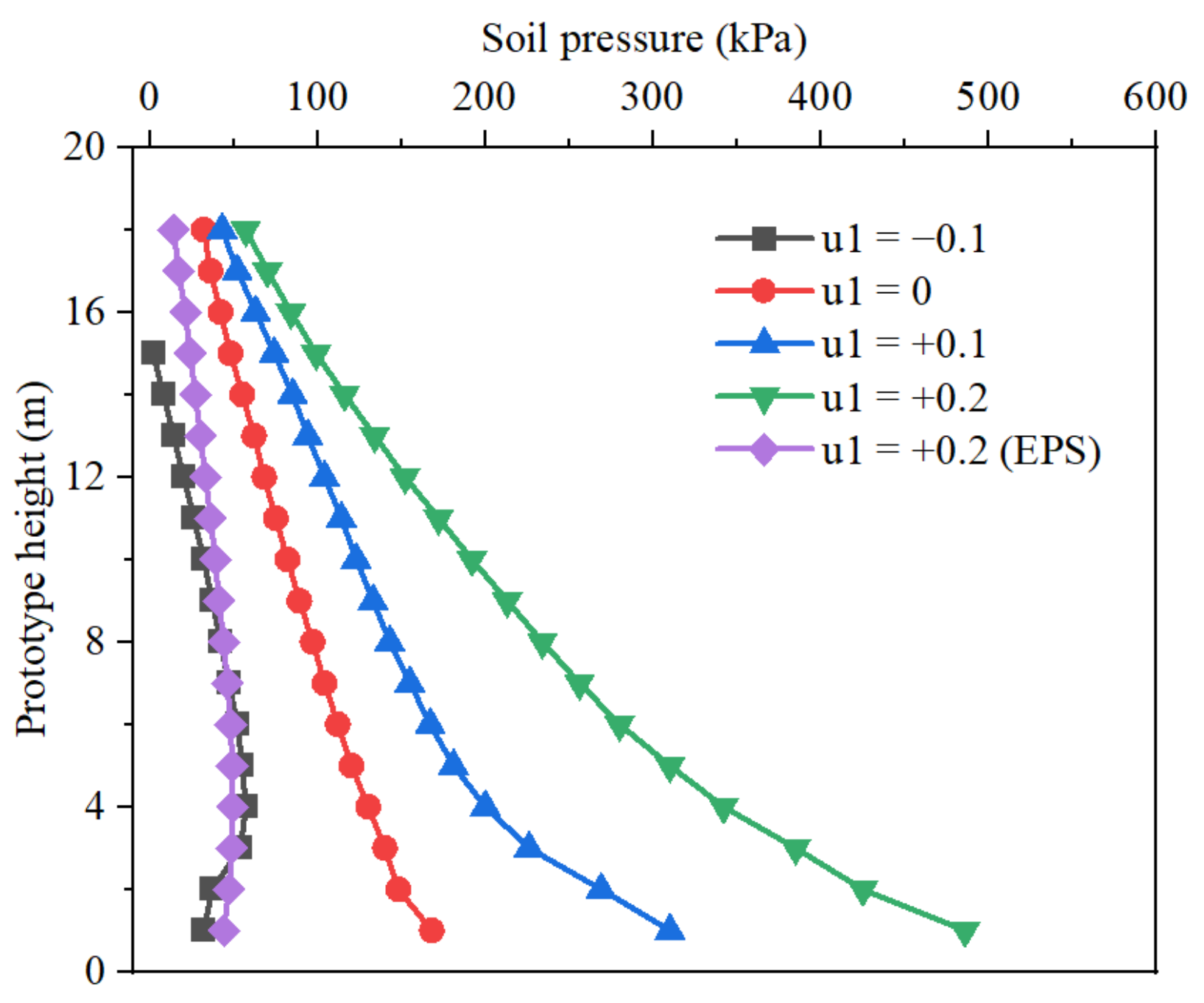
| Model Number | Form of Bridge Abutment Structure | Backfill Materials | Simulation of Geosynthetics |
|---|---|---|---|
| GA1st | Gravity abutment | Clay soil | No Geogrid |
| GA2nd | Geogrid | ||
| GA3th | Gravity abutment | Aeolian sand | No geogrid |
| GA4th | Geogrid | ||
| GA5th | EPS | ||
| GA6th | Geogrid + EPS | ||
| GA7th | Pile-supported Abutment | Aeolian sand | No geogrid |
| GA8th | Geogrid | ||
| GA9th | Geogrid + EPS |
| Name of the Material | Volume Weight (kN/m3) | Void Ratio | Elastic Parameters | Drucker-Prager Parameter | Permeability Coefficient (m/d) | |||
|---|---|---|---|---|---|---|---|---|
| E (kPa) | μ | β (º) | κ | ψ (º) | ||||
| Clay soil (90% compaction degree) | 17.0 | 0.591 | 16,500 | 0.30 | 52.21 | 1.0 | 52.21 | 0.00864 |
| Clay soil (85% compaction degree) | 16.1 | 0.755 | 5330 | 0.35 | 35.60 | 1.0 | 35.60 | 0.01 |
| Reinforced clay soil | 15.5 | 0.755 | 8464 | 0.35 | 38.48 | 1.0 | 38.48 | 0.01 |
| Aeolian sand | 17.0 | 0.588 | 13,385 | 0.32 | 51.78 | 1.0 | 51.78 | 1.0 |
| Reinforced aeolian sand | 17.0 | 0.588 | 20,523 | 0.32 | 53.44 | 1.0 | 53.44 | 1.0 |
| Muddy soft soil | 14.2 | 0.910 | 3000 | 0.45 | 23.06 | 1.0 | 23.06 | 0.0015 |
| Geogrid | 16.2 | 595,000 | 0.15 | 0.003 | ||||
| EPS interlayer | 0.14 | 1500 | 0.25 | 0.03 | ||||
| Treatment Measures | Numerical Results | Test Results | Calculation Error (%) | ||
|---|---|---|---|---|---|
| Average Settlement (mm) | Ratio (%) | Average Settlement (mm) | Ratio (%) | ||
| Aeolian sand | 216.00 | 100.00 | 227.07 | 100.00 | 4.88 |
| Reinforced aeolian sand | 192.40 | 89.07 | 219.30 | 96.58 | 12.27 |
| Aeolian sand + EPS | 222.20 | 102.87 | 231.37 | 101.89 | 3.96 |
| Reinforced aeolian sand + EPS | 200.00 | 92.59 | 223.73 | 98.53 | 10.61 |
| Backfill Materials | Numerical Results P1 (kN/m) | Test Results P2 (kN/m) | Calculation Error |
|---|---|---|---|
| Aeolian sand | 1535.25 | 1502.26 | 2.20 |
| Reinforced aeolian sand | 950.30 | 965.36 | 1.56 |
| Aeolian sand + EPS | 644.16 | 610.25 | 5.56 |
| Reinforced aeolian sand + EPS | 580.79 | 532.87 | 8.99 |
| Treatment Measures | Numerical Results | Test Results | Calculation Error (%) | ||
|---|---|---|---|---|---|
| Average Settlement (mm) | Ratio (%) | Average Settlement (mm) | Ratio (%) | ||
| Aeolian sand | 366.40 | 100.00 | 374 | 100.00 | 2.03 |
| Reinforced aeolian sand | 362.50 | 98.94 | 351 | 93.85 | 3.28 |
| Reinforced aeolian sand + EPS | 376.90 | 102.87 | 361.6 | 96.68 | 4.23 |
Publisher’s Note: MDPI stays neutral with regard to jurisdictional claims in published maps and institutional affiliations. |
© 2022 by the authors. Licensee MDPI, Basel, Switzerland. This article is an open access article distributed under the terms and conditions of the Creative Commons Attribution (CC BY) license (https://creativecommons.org/licenses/by/4.0/).
Share and Cite
Shen, Z.; Fang, L. Centrifugal Model Test and Simulation of Geogrid Reinforced Backfill and EPS Interlayer on Bridge Abutment. Sustainability 2022, 14, 13908. https://doi.org/10.3390/su142113908
Shen Z, Fang L. Centrifugal Model Test and Simulation of Geogrid Reinforced Backfill and EPS Interlayer on Bridge Abutment. Sustainability. 2022; 14(21):13908. https://doi.org/10.3390/su142113908
Chicago/Turabian StyleShen, Zheng, and Lei Fang. 2022. "Centrifugal Model Test and Simulation of Geogrid Reinforced Backfill and EPS Interlayer on Bridge Abutment" Sustainability 14, no. 21: 13908. https://doi.org/10.3390/su142113908





